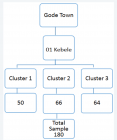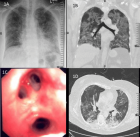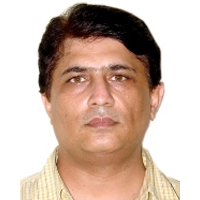Abstract
Research Article
Assessment of Complementary Feeding Practice of infants and young children aged 6-23 months in Gode Town, Somali Regional State of Ethiopia
Yimer Mihretie*
Published: 09 November, 2017 | Volume 1 - Issue 2 | Pages: 045-057
Malnutrition is the largest risk factor caused by inadequate nutrition that leads to childhood morbidity and mortality, as well as inadequate growth and development. Infants are at increased risk of malnutrition by six months, when breast milk alone is no longer sufficient to meet their nutritional requirements. However the factors associated with nutritional status of infants after 6 months of age have received little attention in pastoralist communities of Ethiopia. The aim of this study was to assess the complementary foods of infants and young children (6-23 months) in Gode town of Kebele 01. The prevalences of wasting, stunting and underweight among infants and young children were 6.1%, 56.1%, 10.0% reespectively. Undernutrition is a public health problem among infants and young children in Gode town of Kebele 01. Breastfeeding was slightly positive associated with lower chances of wasting at r=0.61, p= 0.01 and underweight at r=0.331, p=0.01. While diarrheal disease was associated with higher chances of wasting and underweight. Initiation of complementary food was slightly positive association with wasting at r=0.179, p=0.05.
Read Full Article HTML DOI: 10.29328/journal.afns.1001008 Cite this Article Read Full Article PDF
Keywords:
Complementary feeding; Gode; Infants; Malnutrition; Stunting; Wasting
References
- Müller O, Krawinkel M. Malnutrition and health in developing countries. CMAJ. 2005; 173: 279-86. Ref.: https://goo.gl/SrR5Eb
- Pelletier DL. The relationship between child anthropometry and mortality in developing countries: implications for policy, programs and future research. J nutroct. 1994; 124: 2047S-2081S.
- Ethiopian demographic health survey. Complementary feeding practice for infants6-23 months at filtu woreda, Somali regional state. 2011.
- Joan J, Mesfin BH. Report on review of Incorporation of Essential Nutrition Actions into Public Health Programs in Ethiopia. Food and Nutrition Technical Assistance (FANTA) Project. 2008. Ref.: https://goo.gl/LQ9JdK
- The Care Initiative Assessment, Analysis, and Action to Improve Care for Nutrition. UNICEF Nutrition Section. 1997.
- Pelto GH. Improving Complementary Feeding Practices Responsive Parenting As a Primary Component Of Intervention To Prevent Malnutrition In Infancy and Early Childhood. Pediatrics. 2000; 106: 1300-1301. Ref.: https://goo.gl/rH6JHw
- Saha KK, Persson L, Rasmussen KM, Arifeen SE, Frongillo EA, et al. Appropriate infant feeding practices result in better growth of infants and young children in rural Bangladesh. Am J ClinNutr. 2008; 87: 1852-1859. Ref.: https://goo.gl/BhETH9
- World Health Organization. Infant And Young Child Feeding: Model Chapter For Textbooks For Medical Students And Allied Health Professionals. Geneva: WHO Press. 2009.
- World Health Organization. Essential Nutrition Actions: Improving Maternal, Newborn, Infant And Young Child Health And Nutrition. Geneva: WHO Press. 2013.
- Engel PL, Bentley M, Pelto G. The role of care in nutrition programs: current research and a research agenda. Proceedings of the Nutrition Society. 2007; 59: 25-35. Ref.: https://goo.gl/ch68ZH
- Penny ME, Creed-Kanshiro HM, Rbert RC, Narro MR, Caulfield LE, et al. Effectiveness Of An Educational Intervention Delivered Through The Health Services To Improve Nutrition In Young Children: A Cluster-Randomized Controlled Trial. Lancet. 2005; 365: 1863-1872. Ref.: https://goo.gl/QkyjxK
- Patric H, Nicklas TA, Hughes SO, Morales M. The benefits of authoritative feeding style: caregiver feeding styles and children's food consumption patterns. Appetite. 2005; 44: 243-249. Ref.: https://goo.gl/4NjQBG
- Fisaha Haile. Magnitude and Factors Associated with Appropriate Complementary Feeding among Mothers Having Children 6-23 Months-of-Age in Northern Ethiopia; A Community-Based Cross-Sectional Study. 2014; 2: 36-42. Ref.: https://goo.gl/BqKDKj
- WHO Multicenter Growth Reference Study Group. WHO Child Growth Standards: Length/Height-for-Age, Weight for-Age, Weight-for-Length, Weight-for-Height and Body Mass Index-for-Age: Methods and Development, World Health Organization, Geneva. 2006.
- Aweke KA, Habtamu F, Akalu G. Nutritional Status of Children in FoodInsecure Households in Two Districts of North Showa Zone, Ethiopia. Afr JFood AgricNutr Dev. 2012; 12: 5915-5927. Ref.: https://goo.gl/sddBz6
- Disha AD, Rawat R, Subandoro A, Menon P. Infant and young child feeding(IYCF) practices in Ethiopia and Zambia and their association with childnutrition: Analysis of demographic and health survey data. Afr J Food AgricNutr Dev. 2012; 12: 5895-5914. Ref.: https://goo.gl/16n1bk
- Koyanagi A, Humphrey JH, Moulton L, Ntozini R, Mutasa K, et al. Effect ofearly exclusive breastfeeding on morbidity among infants born to HIV-negativemothers in Zimbabwe. Am J ClinNutr. 2009; 89: 1375-1382. Ref.: https://goo.gl/YWNsw8
- Foluke, Sundlay, Aderibigde, Oluwanfun. Complementary feeding, knowledge practice,and dietery diversity among months of under five children in an urban community in lagos, Nigeria. Int j MCH and AIDS. 2017; 6: 46-59.
- Masiye F, Chama C, Chita B, Jonsson D. Determinants of child nutritionalstatus in Zambia: An analysis of a national survey. Zambia SocSci J. 2010; 1: 29-42. Ref.: https://goo.gl/a5XGzH
- World Health Organization. Complementary feeding. 2016.
- Ashmika M, Deerajen R, Pugo-Gunsam P, Rajesh J. An Assessment of the Breastfeeding Practices and infant feeding pattern among mothers in Mauritius. J Nutri Metabolism. 2013. Ref.: https://goo.gl/Z4BenF
- Beyene TT. Predictors of nutritional status of children visiting health facilities inJimma Zone, South West Ethiopia. Int J AdvNursSciPract. 2012; 1: 1-13. Ref.: https://goo.gl/dvucLd
- Gibson RS, Abebe Y, Hambidge KM, Arbide I, Teshome A, et al. Inadequate feeding practices and impaired growth among children fromsubsistence farming households in Sidama, Southern Ethiopia. MaternChildNutr. 2009; 5: 260-275. Ref.: https://goo.gl/y5xHhV
- Patterns and determinants of breastfeeding and complementary feeding practices of Mothers in the United Arab Emirates. BMC Public Health. 2013; 13: 171. Ref.: https://goo.gl/vcdw91
- Ma'alin A, Birhanu D, Melaku S, Tolossa D, Yuusuf Mdet al. Magnitude And Factors Associated with Malnutrition among Children 6-59 Months of Age in Shinile Woreda, Reginal State. BMC Nutrition. 2016; 2: 44. Ref.: https://goo.gl/PVYKN3
- Mesfin A, Henry C, Girma M, Susan JW. Use of Pulse Crops in Complementary Feeding of 6-23-Month-Old Infants and Young Children in Taba Kebele, Damot Gale District, Southern Ethiopia. J Public Health Africa. 2015; 6: 357. Ref.: https://goo.gl/zoCBJi
- Baye K, Guyot JP, Icard-Vernière C, Mouquet-Rivier C. Nutrient intakes from complementary foods consumed by young children (aged 12-23 months) from North Wollo, northern Ethiopia: the need for agro-ecologically adapted interventions. Public health nutrition. 2013; 16: 1741-1750. Ref.: https://goo.gl/nMpsWA
- Dewey KG, Brown KH. Update on technical issues concerning complementary feeding of young children in developing countries and implication for intervention programs. Food and Nutrition bulletin. 2003; 24: 5-28. Ref.: https://goo.gl/MgMdvo
- Dewey KG. Nutrition, growth and complementary feeding of the breastfed infants. Pediatrics. American clinical nutrition. 2001; 48: 87-104. Ref.: https://goo.gl/uWW8oh
- European Food Safety Authority. Scientific opinion on the appropriate age for introduction of complementary feeding of infants: EFSA. EFSA J. 2009; 7: 1423. Ref.: https://goo.gl/P13nQf
- Gluck man, Pinal. Factors affect Under nutrition of the mother at conception and during pregnancy. BMC nutrition. 2013.
- Imdad A, Yakoob MY, Bahutta ZA. Impact of maternal education about complementary feeding and provision of complementary food on child growth in developing countries. BMC Public Health. 2011; 11: S3-S25. Ref.: https://goo.gl/kuwb3V
- Kakute P, Ngum J, Mitchell P, Kroll K, Forgwei G, et al. Cultural Barriers to Exclusive Breastfeeding by Mothers in a Rural Area of Cameroon, Africa. American College of Nurse-Midwives. 2005; 50: 324-328. Ref.: https://goo.gl/DZY6x4
- Lander R, Enkhjargal TS, Batiargal J, Bolormaa N, Enkhmyagmar D,et al. Poor Dietary Quality Of Complementary Foods Is Associated With Multiple Micronutrient Deficiencies During Early Childhood In Mongolia. J Public Health Nutrition. 2010; 13: 1304-1313. Ref.: https://goo.gl/CjqaZ9
- Mwaura W, Moloney G. Somali knowledge, attitude and practice study on infant and young child feeding and health seeking practices. United Nations Food and Agricultural Organization/Food Security Analysis. 2007; 36-61.
- Nestel P, Brined A, Benoist B, Decker E, Ferguson E, et al. Complementary food supplements to achieve micronutrient adequacy for infant and young children. J pediatrics Gastroenterol nutri. 2003; 36: 316-328. Ref.: https://goo.gl/LFd6Q5
- Ruel MT, Menon P. Factors Causing Malnutrition among under Five Children in Bangladesh. Pakistan J Nutrition. 2006; 5: 558-562. Ref.: https://goo.gl/K9ngPk
- Shrimpton R, Victora CG, De Onis M, Lima RC, Blossner M, et al. World Timing Of Growth Faltering: Implications For Nutritional Intervention. J Pediatrics. 2001; 107: E75. Ref.: https://goo.gl/eP8Kgh
- Stewart CP, Lannott L, Dewey KG, Michaelsen KF, Onyango AW. Contextualizing Complementary Feeding In A Broader Framework For Stunting Prevention. Maternal and Child Nutrition. 2013; 9: 27-45. Ref.: https://goo.gl/z4923n
- Infant and Young Child Feeding, Nutrition Section Program, UNICEF Pub Med. 2012.
- United Nation Children's Fund. Improving Child Nutrition, the Achievable Imperative for Global Progress. UNICEF Pub Med. 2013.
- World Health Organization Geneva. Iron Deficiency Anemia. In Assessment, Editor. Prevention and Control. A Guide for Program Managers. 2001.
- World Health Organization. Complementary Feeding. Report Of The Global Consultation, And Summary Of Guiding Principles For Complementary Feeding Of The Breastfed Child. Geneva: WHO Press: WHO. 2002.
- World Health Organization. The World Health Organizations Infant-Feeding Recommendation. Bulletin WHO. 1995; 73: 165-174
Figures:

Figure 1
Similar Articles
-
Assessment of Complementary Feeding Practice of infants and young children aged 6-23 months in Gode Town, Somali Regional State of EthiopiaYimer Mihretie*. Assessment of Complementary Feeding Practice of infants and young children aged 6-23 months in Gode Town, Somali Regional State of Ethiopia. . 2017 doi: 10.29328/journal.afns.1001008; 1: 045-057
-
Lemongrass tea consumption and changes in Acid-Base Balance and Electrolyte homeostasisChristopher E Ekpenyong*. Lemongrass tea consumption and changes in Acid-Base Balance and Electrolyte homeostasis. . 2018 doi: 10.29328/journal.afns.1001016; 2: 041-051
-
Iodine status and thyroid parameters of pregnant women living in an iodine sufficient areaFereidoun Azizi*,Hossein Delshad,Parvin Mirmiran,Ladan Mehran,Maryam Tohidi. Iodine status and thyroid parameters of pregnant women living in an iodine sufficient area. . 2021 doi: 10.29328/journal.afns.1001026; 5: 001-006
-
Mild to moderate iodine deficiency in pregnancy: A matter of debateFereidoun Azizi*,Hossein Delshad. Mild to moderate iodine deficiency in pregnancy: A matter of debate. . 2021 doi: 10.29328/journal.afns.1001028; 5: 018-026
-
Mapping of Local Therapeutic Foods (LTF) and Micronutrients (MN); their logistics in community-based management of Severe Malnutrition (SAM, SUW) as a benchmark in tribal Melghat, MaharashtraAshish Satav*,Vibhawari Dani,Jayashri Pendharkar,Dipty Jain,Kavita Satav. Mapping of Local Therapeutic Foods (LTF) and Micronutrients (MN); their logistics in community-based management of Severe Malnutrition (SAM, SUW) as a benchmark in tribal Melghat, Maharashtra. . 2022 doi: 10.29328/journal.afns.1001034; 6: 026-034
-
Perceptions of Adolescent Mothers on Feeding and Nutrition of their Children aged 0-3 Years in Rural BangladeshFaiza Farzana*, Tanvir Sarwar. Perceptions of Adolescent Mothers on Feeding and Nutrition of their Children aged 0-3 Years in Rural Bangladesh. . 2023 doi: 10.29328/journal.afns.1001050; 7: 054-064
-
Impact of Moringa oleifera Leaf Flour supplement on Weight Gain in Moderately Acutely Malnourished Children in BeninLaleye Flora Tinouade Founmilayo*, Fanou Fogny Nadia and Kayode Polycarpe. Impact of Moringa oleifera Leaf Flour supplement on Weight Gain in Moderately Acutely Malnourished Children in Benin. . 2023 doi: 10.29328/journal.afns.1001052; 7: 070-077
Recently Viewed
-
Relationship between Vitamin D Deficiency and Lipopolysaccharides Porphyromonas gingivalis Bacteria in Stunting ChildrenErwin Gunawan*,Ria Puspitawati. Relationship between Vitamin D Deficiency and Lipopolysaccharides Porphyromonas gingivalis Bacteria in Stunting Children. Ann Biomed Sci Eng. 2024: doi: 10.29328/journal.abse.1001033; 8: 059-065
-
Addiction to self-strangulation: a case-reportAurely Ameller*,Yann Le Strat,Marion Cadranel,Celine Portalier, Caroline Dubertret. Addiction to self-strangulation: a case-report . J Addict Ther Res. 2017: doi: 10.29328/journal.jatr.1001003; 1: 016-021
-
Nanoencapsulated Extracts from Leaves of Bauhinia forficata Link: In vitro Antioxidant, Toxicogenetic, and Hypoglycemic Activity Effects in Streptozotocin-induced Diabetic MiceBárbara Verônica Cardoso de Souza, Alessandra Braga Ribeiro*, Rita de Cássia Meneses Oliveira, Julianne Viana Freire Portela, Ana Amélia de Carvalho Melo Cavalcante, Esmeralda Maria Lustosa Barros, Luís Felipe Lima Matos, Tarsia Giabardo Alves, Maria. Nanoencapsulated Extracts from Leaves of Bauhinia forficata Link: In vitro Antioxidant, Toxicogenetic, and Hypoglycemic Activity Effects in Streptozotocin-induced Diabetic Mice. Arch Pharm Pharma Sci. 2024: doi: 10.29328/journal.apps.1001063; 8: 100-115
-
Oral Suspension as Versatile Galenic Formulation in PediatryMauro Luisetto*, Almukthar N, Edbey K, Mashori GR, Fiazza C, Dona’ l, Cabianca L, Latyshev O. Oral Suspension as Versatile Galenic Formulation in Pediatry. Arch Pharm Pharma Sci. 2024: doi: 10.29328/journal.apps.1001062; 8: 091-099
-
Modulation of Microbiota and its Impact on DepressionKousik Maparu*. Modulation of Microbiota and its Impact on Depression. Arch Pharm Pharma Sci. 2024: doi: 10.29328/journal.apps.1001061; 8: 089-090
Most Viewed
-
Evaluation of Biostimulants Based on Recovered Protein Hydrolysates from Animal By-products as Plant Growth EnhancersH Pérez-Aguilar*, M Lacruz-Asaro, F Arán-Ais. Evaluation of Biostimulants Based on Recovered Protein Hydrolysates from Animal By-products as Plant Growth Enhancers. J Plant Sci Phytopathol. 2023 doi: 10.29328/journal.jpsp.1001104; 7: 042-047
-
Sinonasal Myxoma Extending into the Orbit in a 4-Year Old: A Case PresentationJulian A Purrinos*, Ramzi Younis. Sinonasal Myxoma Extending into the Orbit in a 4-Year Old: A Case Presentation. Arch Case Rep. 2024 doi: 10.29328/journal.acr.1001099; 8: 075-077
-
Feasibility study of magnetic sensing for detecting single-neuron action potentialsDenis Tonini,Kai Wu,Renata Saha,Jian-Ping Wang*. Feasibility study of magnetic sensing for detecting single-neuron action potentials. Ann Biomed Sci Eng. 2022 doi: 10.29328/journal.abse.1001018; 6: 019-029
-
Pediatric Dysgerminoma: Unveiling a Rare Ovarian TumorFaten Limaiem*, Khalil Saffar, Ahmed Halouani. Pediatric Dysgerminoma: Unveiling a Rare Ovarian Tumor. Arch Case Rep. 2024 doi: 10.29328/journal.acr.1001087; 8: 010-013
-
Physical activity can change the physiological and psychological circumstances during COVID-19 pandemic: A narrative reviewKhashayar Maroufi*. Physical activity can change the physiological and psychological circumstances during COVID-19 pandemic: A narrative review. J Sports Med Ther. 2021 doi: 10.29328/journal.jsmt.1001051; 6: 001-007

HSPI: We're glad you're here. Please click "create a new Query" if you are a new visitor to our website and need further information from us.
If you are already a member of our network and need to keep track of any developments regarding a question you have already submitted, click "take me to my Query."
















































































































































